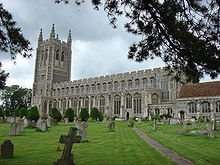
A wool church is an English church financed primarily by donations from rich merchants and farmers who had benefitted from the medieval wool trade, hoping to ensure a place in heaven due to their largesse.[1]
Wool churches are common in the Cotswolds and in the "wool towns" of upland East Anglia, where enormous profits from the wool business spurred construction of ever-grander edifices. A wool church was often built to replace a smaller or less imposing place of worship, in order to reflect the growing prosperity of the community in which it was situated. Many such building projects were undertaken by a small number of families in each village or town, who used the new church building to display their own wealth, status and faith. The building of wool churches largely ended with the English Reformation and the simultaneous decline of the wool trade between 1525 and 1600.
- ^ "A Look at Some of the Historic Textile Hot Spots in the UK". Stuart Morris. Stuart Morris Co. UK. 2016.
Sheep farmers became incredibly rich exporting the 'golden fleece' and, with religious orders owning many flocks, much of the money went into building churches. Rich merchants also wanted to ensure their safe passage to paradise and so would donate portions of their profits towards building these 'wool churches'.